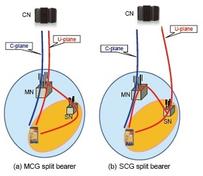D2D Communication: Advantages and Disadvantages
Advertisement
This page covers the advantages and disadvantages of D2D (Device-to-Device) communication used in LTE and 5G NR. It outlines the benefits and challenges associated with this technology.
What is D2D Communication?
D2D communication allows direct communication between two UEs (User Equipments), with or without the network (Access Point (AP) or Base Station (BS)). These devices can be cell phones or vehicles.
For a direct link to work, the devices need to be in close proximity. D2D was introduced in LTE as an extension and is being explored as an integral part of the overall wireless access solution in 5G. Common short-range wireless technologies that use D2D communication include Wi-Fi Direct, Bluetooth, and LTE Direct.

In this technique, the network authorizes the two devices to communicate directly under its control. The network maintains control over devices and can determine traffic routing between direct and network paths. This means that devices can communicate directly even when the network is unavailable.
D2D is mainly classified into two types:
- Inband D2D: Uses the same licensed spectrum for both cellular and D2D communication.
- Outband D2D: Uses unlicensed spectrum for D2D communication, separate from cellular communication.
There are two types of communication in D2D:
- Single-hop: The transmitting and receiving UEs connect directly with each other.
- Multi-hop: Intermediate UEs act as relays, either between “BS and UE” or between “two UEs.”
D2D has many use cases, including local data services, data offloading, coverage extension, and M2M communication.
Benefits or Advantages of D2D Communication
Here are the key advantages of D2D communication:
-
Ultra-low Latency: D2D offers ultra-low latency communication, resulting in more reliable connectivity between devices.
-
Solves Network Capacity Issues: By enabling direct device connectivity without involving the network, D2D alleviates network capacity issues in cellular systems.
-
Extends Coverage: If a UE (UE#1) is at the cell edge and receives a poor signal from the network, a nearby UE (UE#2) can provide a better signal, effectively extending coverage.
-
Relay Functionality: One UE (UE#1) can provide service to another UE (UE#2). For example, if UE#2’s connection with the BS breaks, UE#1 can act as a relay to provide information to UE#2.
-
Increased Flexibility for Operators: D2D connectivity allows operators to offload traffic from the core network to devices, which increases spectral efficiency and reduces energy and cost per bit.
-
Utilizes mmWave Frequencies in 5G: In 5G, D2D uses mmWave frequencies, which allows many D2D links to operate simultaneously due to its robustness against multi-user interference.
-
Enhanced Security: D2D communication offers stronger security than conventional cellular communication because data is not stored at a central location.
Challenges or Disadvantages of D2D Communication
Despite its advantages, D2D communication also presents some challenges:
-
Synchronization Issues: UEs synchronize using periodic broadcasts from the BS. However, in certain situations, it can be difficult for UEs to communicate due to synchronization issues. This can occur when UEs belong to different BSs, some are in coverage and some are outside, or all UEs lie outside coverage.
-
Peer Discovery Algorithm: The peer discovery algorithm used in D2D is challenging in multicell networks, especially when cooperation from adjacent BSs is difficult to obtain.
-
Interference Management: Interference management is a critical task in D2D.
- In Inband D2D communication, cellular and D2D links interfere with each other.
- In Outband D2D communication, D2D links interfere with each other, as well as with other devices using the same band.
UEs transmit low power to reduce interference, but this can compromise QoS (Quality of Service).
-
Charging Models: Determining how to charge users for D2D services is a common issue for cellular operators.
-
Security Threats: Though D2D provides better security, it is still prone to attacks such as eavesdropping, IP spoofing, denial of service, and malware attacks.
Advertisement
 RF
RF

